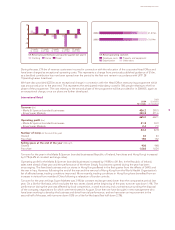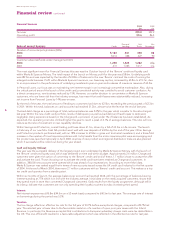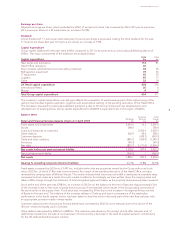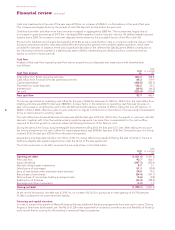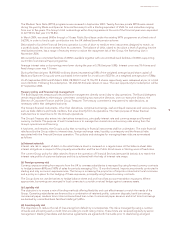Marks and Spencer 2004 Annual Report Download - page 17
Download and view the complete annual report
Please find page 17 of the 2004 Marks and Spencer annual report below. You can navigate through the pages in the report by either clicking on the pages listed below, or by using the keyword search tool below to find specific information within the annual report.
financial statements and a review of the nature and
scope of the external audit.
Any significant findings or identified risks are closely
examined so that appropriate action can be taken.
Management is called upon to present action plans and
give assurance. The audit committee has completed its
review of the effectiveness of the Group’s systems of internal
control during the year.
Internal audit’s work is focused on areas of priority as
identified by the Group Risk Profile and in accordance with
an annual audit plan approved each year by the audit
committee and by the Board. The Board receives a full
report from the Chief Internal Auditor each year on the
department’s work and findings and regular interim updates
on specific issues.
The external auditors are engaged to express an opinion on
the financial statements. They review and test the systems of
internal financial control and the data contained in the
financial statements to the extent necessary to express their
audit opinion. They discuss with management the reporting
of operational results and financial position of the Group
and present their findings to the audit committee.
Relations with shareholders
We are committed to ongoing communication with all
shareholders and have a well established cycle of
communication. Our Investor Relations department is the
focal point for contact with institutional investors and
maintains regular dialogue throughout the year. All Company
announcements and presentations are made available
simultaneously on our website, which also contains corporate
and customer information updated on a regular basis.
The Chairman ensures that the Board is regularly updated
on institutional shareholder views following meetings they
have with him, the Chief Executive or Finance Director. In
June, the Board receives a presentation summarising the
opinions of our principal shareholders following an
extensive survey on their views after the release of our
fourth quarter trading statement in April.
Our AGM, held in July, is well attended by shareholders who
receive a business presentation from the Chairman and Chief
Executive and have the opportunity to ask questions of the
full Board, including the chairmen of the audit, remuneration
and nomination committees. In July 2003, all AGM
resolutions were passed on a show of hands and we received
proxy votes representing 51.52% of the ordinary share capital
with votes ‘for’ resolutions ranging from 91.8% to 99.9%.
Having reviewed the recommendations of the Review by
Paul Myners of the impediments to voting UK shares, the
Board has taken the following action to increase the level of
voting for the AGM in 2004:
•campaign ‘your vote counts’ and encourage the greater
use of electronic voting;
•introduce three-way voting on AGM resolutions:
‘for’, ‘against’ and ‘vote withheld’;
•conduct the vote at the AGM by poll rather than by
show of hands.
Compliance with the Code
The directors consider that for the year ended 3 April 2004,
the Company complied with all the provisions of the
existing Code and has put in place procedures to enable it
to report future compliance with the new Code, which takes
effect for Marks & Spencer from 4 April 2004.
15
www.marksandspencer.com
integral part of planning and review, managers from each
business area and major projects identify the risks to their
plans, the probability of those risks occurring, the impact if
they do occur and the actions being taken to manage those
risks to the agreed boundaries for risk-taking. This
information is communicated upwards on a filter basis,
culminating in a comparison with the executive directors’
assessment of the Group’s risks and discussion by the Board.
This process has been in place for the year under review and
up to the date of approval of the annual report and accounts.
It has been regularly reviewed by the Board and accords with
the Internal Control Guidance for directors on the Combined
Code produced by the Turnbull Working Party.
Internal control
The Board maintains full control and direction over
appropriate strategic, financial, organisational and
compliance issues. It has delegated to executive
management the implementation of the systems of
internal control within an established framework.
The Board has put in place an organisational structure with
formally defined lines of responsibility and delegation of
authority. There are also established procedures for planning,
capital expenditure, information and reporting systems, and
for monitoring the Group’s businesses and their
performance. These include:
Purpose and aims
•communication of the Group’s strategy, objectives and
targets
Plans and policies
•annual and three-year operating and capital plans;
•operating policies and procedures;
•clearly defined capital investment control guidelines;
•review of treasury policies by the Treasury Committee; and
•review of social, environmental and ethical matters by
the Corporate Social Responsibility Committee
Competent people
•appointment of employees of the necessary calibre to
fulfil their allotted responsibilities; and
•clear roles and accountabilities with regular performance
reviews
Monitor and control
•review by operating divisions of their plans with the
relevant executive directors prior to submission to the
Board for approval, including identification and
assessment of risks;
•monthly comparison of operating divisions’ actual
financial performance against budget; and
•regular consideration by the Board of year-end forecasts
Regulatory update
•reporting of accounting and legal developments; and
•regular briefings on latest best practice corporate
governance to the Board.
Assurance
On behalf of the Board, the audit committee examines the
effectiveness of the Group’s:
•assessment of risk by reviewing evidence of risk
assessment activity and a report from internal audit on
the risk assessment process; and
•systems of internal control primarily through confirming
the scope of the internal audit programme and
reviewing its findings, reviews of the annual and interim


